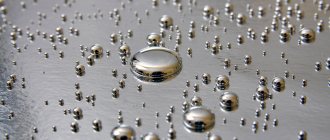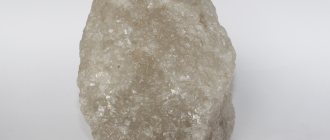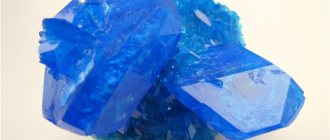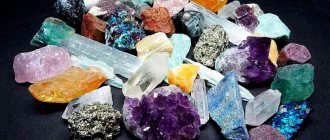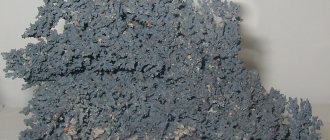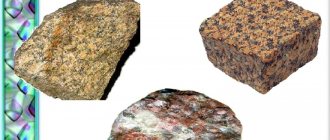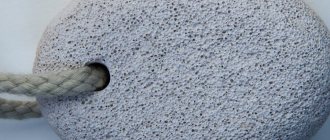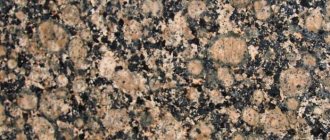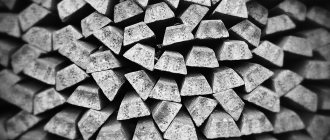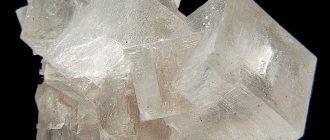Author: Dimon
November 17, 2022 00:23
Community: How it's made, how it works, how it works
Tags: how it's done subsurface mercury
20751
5
Everyone knows about such an unusual metal as mercury. Everyone remembers what it looks like and how dangerous its fumes are to humans. But do you know how mercury is mined?
0
The extraction of mercury at all times has not been without losses for humanity. But there has always been interest in it, especially among artisans in Central Asia. It was here that the first mercury mines appeared in the 6th-4th centuries BC.
Origin story
Mercury has been known since at least 1500 BC. It was used to create medicines that were supposed to prolong life and give immortality.
In the IV-III centuries BC. Aristotle and Theophastus mention mercury, calling it liquid silver. Dioscorides also wrote a little later about the process of obtaining mercury from cinnabar.
The most important metal was gold, which in ancient times was associated with the Sun. Mercury was considered a minor metal after gold. Therefore, it was called mercury, in honor of Mercury, the planet closest to the Sun.
It was also called liquid silver, due to its external resemblance to this metal. And because of the mobility of mercury, it was sometimes called living silver.
What does mercury look like?
In Ancient China and India they believed in the healing properties of this metal. Alchemists also tried to obtain gold from sulfur and mercury.
Mercury reserves and production
A metal called mercury is found in the mineral cinnabar. This is a red stone that has long been used as a dye. The substance can also be found in other minerals, but in minute quantities. Therefore, the main source of mercury is cinnabar. It contains about 85% mercury sulfide.
Mercury is a very valuable metal, since it is only in a liquid aggregate state at room temperature. There is no other substance that has properties similar to mercury. Therefore, it is mined in all countries.
Cinnabar stones can be large or grain-sized. They are usually located at shallow depths. The metal is released from cinnabar when heated. At elevated temperatures, mercury begins to be released from the ore in small drops, which flow into pre-prepared tanks.
Where is mercury mined? The largest deposits of cinnabar are found in Italy, Spain, Canada, the USA, and many Asian countries. The richest country in mercury is Spain - it contains 75% of the world's reserves of the metal. The largest deposit is the Almaden mine, which began to be developed more than 2000 years ago. Russia also has mercury deposits. It is mainly mined in Altai, Kamchatka and Kakaz.
Being in nature
Mercury is a relatively rare element in the earth's crust with an average concentration of 83 mg/t. However, due to the fact that mercury weakly binds chemically to the most common elements in the earth's crust, mercury ores can be very concentrated compared to ordinary rocks. The most mercury-rich ores contain up to 2.5% mercury. The main form of mercury in nature is dispersed, and only 0.02% of it is contained in deposits. The mercury content in different types of igneous rocks is close to each other (about 100 mg/t). Among sedimentary rocks, the maximum concentrations of mercury are found in clay shales (up to 200 mg/t). The mercury content in the waters of the World Ocean is 0.1 µg/l. The most important geochemical feature of mercury is that among other chalcophile elements it has the highest ionization potential. This determines such properties of mercury as the ability to be reduced to an atomic form (native mercury), significant chemical resistance to oxygen and acids.
Mercury is present in most sulfide minerals. Its especially high contents (up to thousandths and hundredths of a percent) are found in fahlores, stibnites, sphalerites and realgars. The proximity of the ionic radii of divalent mercury and calcium, monovalent mercury and barium determines their isomorphism in fluorites and barites. In cinnabar and metacinnabarite, sulfur is sometimes replaced by selenium or tellurium; The selenium content is often hundredths and tenths of a percent. Extremely rare mercury selenides are known - timanite (HgSe) and onofrite (a mixture of timanite and sphalerite).
Mercury is one of the most sensitive indicators of hidden mineralization not only of mercury, but also of various sulfide deposits, therefore mercury halos are usually detected above all hidden sulfide deposits and along pre-ore faults. This feature, as well as the low mercury content in rocks, is explained by the high elasticity of mercury vapor, which increases with temperature and determines the high migration of this element in the gas phase.
Under normal conditions, cinnabar and metallic mercury are insoluble in water, but in the presence of certain substances (Fe2(SO4)3, ozone, hydrogen peroxide), the solubility of these minerals in water reaches tens of mg/l. Mercury dissolves especially well in alkali metal sulfides, forming, for example, the HgS•nNa2S complex. Mercury is easily sorbed by clays, iron and manganese hydroxides, shales and coals.
About 20 mercury minerals are known in nature, but the main industrial value is cinnabar HgS (86.2% Hg). In rare cases, the subject of extraction is native mercury, metacinnabarite HgS and fahl ore - schwatzite (up to 17% Hg). At the only Guitzuco deposit (Mexico), the main ore mineral is livingstonite HgSb4S7. In the oxidation zone of mercury deposits, secondary mercury minerals are formed. These include, first of all, native mercury, less commonly metacinnabarite, which differ from the same primary minerals in greater purity of composition. Calomel Hg2Cl2 is relatively common. Other supergene halide compounds are also common at the Terlingua deposit (Texas): terlinguaite Hg2ClO, eglestonite Hg4Cl.
Place of Birth
Mercury is considered a rare metal.
One of the world's largest mercury deposits is located in Spain (Almaden). There are known deposits of mercury in the Caucasus (Dagestan, Armenia), Tajikistan, Slovenia, Kyrgyzstan (Khaidarkan - Aidarken), Donbass (Gorlovka, Nikitovsky mercury plant).
There are 23 mercury deposits in Russia, industrial reserves amount to 15.6 thousand tons (as of 2002), of which the largest have been explored in Chukotka - West Palyanskoye and Tamvatneyskoye.
Features of structure and properties
Mercury has a rhombohedral lattice structure. That is, the atoms in a mercury crystal are located in the corners of the rhombohedron.
It is the only metal that is liquid at room temperature. Melts at a temperature of -38 degrees Celsius. It is diamagnetic, that is, its atoms are magnetized against the earth's magnetic field. With other metals it can form alloys - amalgams, which can have a solid or liquid state of aggregation. Does not react with iron, niobium, tantalum, tungsten, cobalt and some other metals.
Mercury is a low-active metal from a chemical point of view. It is insoluble in acids, but can be dissolved in aqua regia (a mixture of hydrochloric and nitric acids). It can also be dissolved in concentrated nitric acid, taken in excess.
Mercury melts at a temperature of 38 degrees Celsius
When heated to 300 degrees, it reacts with oxygen, forming red mercury oxide. The reaction is reversible. With further heating, the substance decomposes to its original substances.
The metal also reacts with sulfur. It interacts with halogens, but slowly in the cold, better when heated. And an alkaline solution of potassium permanganate oxidizes the metal.
Scope of application
The interesting thing is where mercury is used. Despite its high toxicity, the substance is widely used. Here are the main areas in which metal is used:
- Medicine. In the past, mercury was added to various medications. But due to the high toxicity, mercury-based drugs were banned. Now it is used only for preserving some vaccines and in thermometers. But until the 70s of the 20th century, mercury was used very actively in medicine. For example, they produced laxatives, diuretics and antiseptics.
- Technique. Mercury is used for mercury thermometers, and fluorescent lamps are filled with it. It is used in position sensors, sealed switches, and some current sources.
- Metallurgy. Metallic mercury is used to make various alloys. Amalgams of gold and silver were previously used in jewelry and for coating mirrors. But due to their high toxicity, they began to be used less frequently. Mercury perfectly wets gold, which is why it is used in gold mining.
- Chemical industry. Mercury salts are used in the industrial production of acetaldehyde from acetylene. Nessler's reagent, potassium tetraiodomercurate, is also often used.
- Agriculture. Some mercury compounds are used for grain dressing and as pesticides. But such substances are very toxic.
Mercury and its compounds are very toxic and can harm the human body. Therefore, when working with such a substance, you must follow your own safety rules - be sure to wear gloves and a protective mask.
Healing effect
It is known that long before our era, mercury compounds were already used in China to treat leprosy. For the same purpose, that is, eliminating skin diseases, the Arabs also used such compounds, and this method of therapy has been preserved until the present day. In Europe at the beginning of the century, mercury ointments were used to treat syphilis, since the toxic properties of the chemical element can destroy most microorganisms that cause ulcers and inflammatory processes on the skin. From time to time it was prescribed as an aphrodisiac.
After the advent of antibiotics, such use of the mineral sharply decreased, and currently cinnabar products remain only in the arsenal of lithotherapists, either for contemplating the stone in order to stimulate sexual functions and restore mental balance, or for very short-term direct contact of the patient with the mineral.
The danger of mercury to the human body
Mercury belongs to the first hazard class. All its compounds with metals and non-metals are also very toxic. Let's figure out why mercury is dangerous for the human body.
Mercury is classified as hazard class 1
If exposed to even small amounts of mercury, it can lead to serious health problems. It is especially dangerous for pregnant women. The substance has a detrimental effect on the developing fetus. It is also dangerous for children in the first years of life - it can slow down development or lead to improper functioning of organs and systems. It has a negative effect on the nervous, digestive, and immune systems.
Mercury vapor and soluble compounds are very toxic. In metal form it is less dangerous. At room temperature it begins to gradually evaporate. The higher the temperature, the more intense evaporation will occur.
If the substance enters the body, it can cause poisoning. Intoxication can be mild, moderate or severe. In especially severe cases, death can occur.
Mercury and all its compounds affect the gastrointestinal tract, kidneys, central nervous system, liver, and respiratory tract. The substance is very dangerous, and its vapors lead to environmental pollution. The most dangerous is the penetration of mercury into water, since under the influence of microorganisms, methylmercury can be formed, which is even more toxic.
All organic mercury compounds, including methylmercury, are capable of interacting with elements of human enzymatic systems, leading to their destruction.
What to do if the thermometer is broken
A broken thermometer may seem like a minor problem, but it's still a problem. It will contain at least 2 grams of mercury, which is not enough. Even on government portals, in particular on mos.ru, there is an answer to the question of what to do in this case.
If you spill a small amount of mercury (a broken thermometer), first remove people and animals from the room, then open the window and close the door. It is also necessary to protect the respiratory system with a mask or bandage. After this, immediately begin collecting mercury.
It looks very harmless, but you shouldn't relax.
Two grams of mercury, which are contained in one thermometer, in a closed room with a volume of 20 cubic meters create a vapor concentration that is thousands of times higher than the level safe for humans.
How to collect mercury
When collecting mercury, do not sweep it away with a broom under any circumstances, so as not to provoke the formation of fine mercury dust. The larger the drops, the better. A vacuum cleaner is also a bad help, since the evaporated mercury will pass through the filters and end up in the air in an even more dangerous form.
A small amount of mercury leaked from a thermometer can be collected using an ordinary medical bulb or a sheet of paper and a knitting needle or thick needle. Pieces of plaster can be used to collect the smallest drops.
Put everything you collected and what you used to collect it in a jar and close the lid tightly. After this, thoroughly clean the scene. A good option would be to wipe this area with a solution of manganese or a soap-soda solution. When you finish cleaning, be sure to wash your hands thoroughly with soap.
Wash your hands thoroughly after cleaning up mercury.
How to throw away a broken thermometer and the mercury from it
Never throw collected mercury down the garbage disposal or sewer. This may lead to a further risk of uncontrolled infection. Place the jar of collected waste on the balcony or in the garage and, as soon as possible, hand it over to the demercurization center for disposal.
How to understand that you have been poisoned by mercury
Symptoms of mercury poisoning take approximately 8 to 24 hours to appear. The main symptoms include general weakness, pain when swallowing, headache and fever. After some time, the gums and stomach begin to ache, and gastric disorders and even pneumonia appear. There have even been cases of death.
Skin cream can cause poisoning. How to avoid this?
Mercury price
Mercury itself is inexpensive - from 4 to 10 dollars per kilogram. This refers to a very pure and high quality substance. In Russia, the price of mercury is about 12-30 rubles per kilogram. This cost is due to the fact that there are many deposits of the substance, and on an industrial scale it is used in small quantities. But buying mercury is impractical and illegal. It is very dangerous and can lead to serious environmental pollution.
Storing, selling and distributing mercury is prohibited by law. Stealing the substance from businesses that use mercury may be a criminal offense.
Thus, mercury has unique properties, due to which it is widely used. But it is highly toxic, so it must be used with caution.
